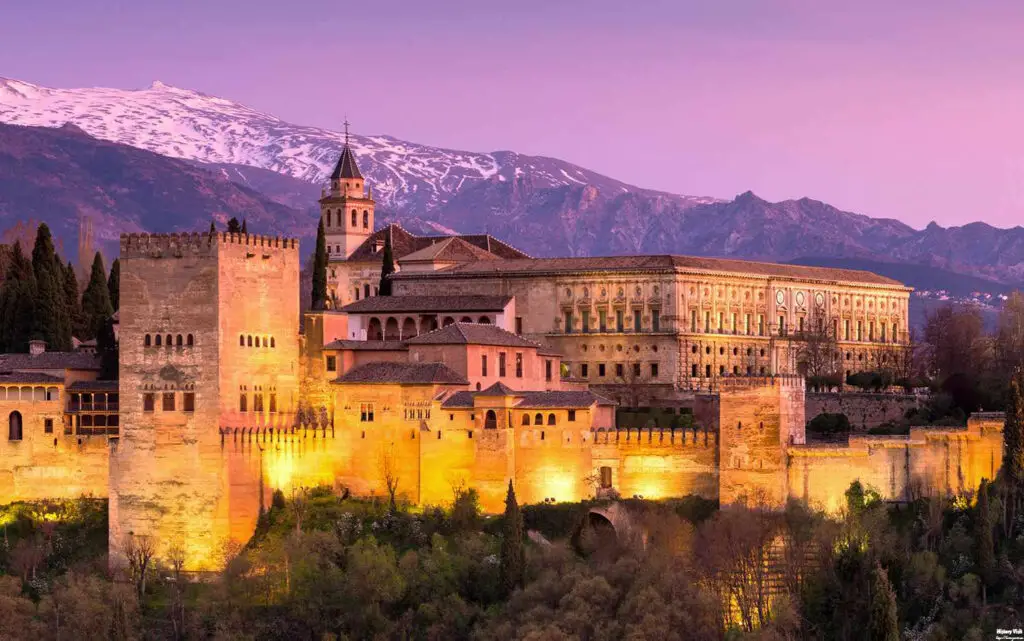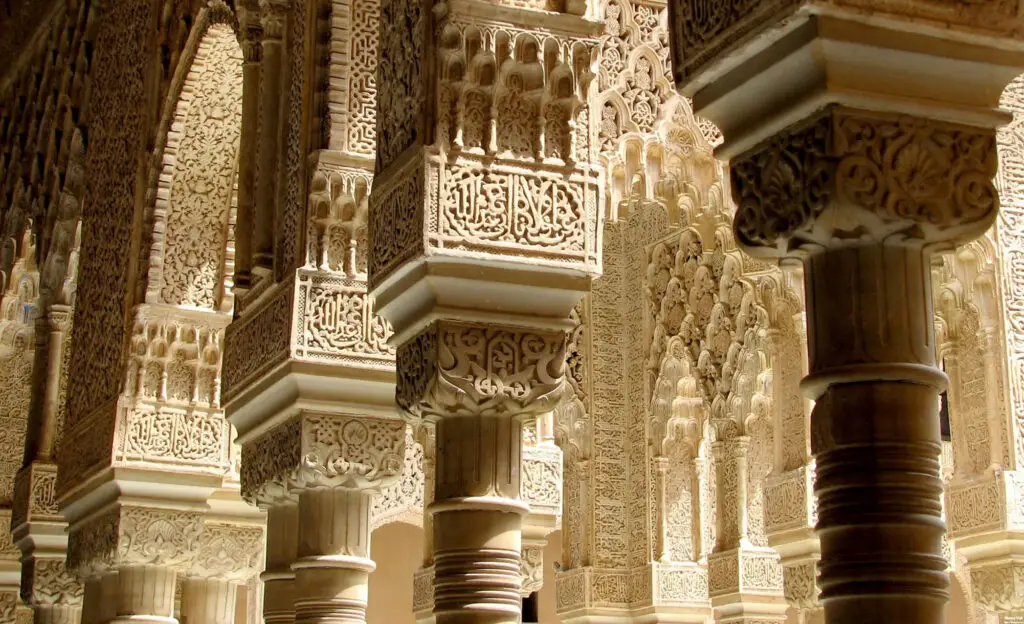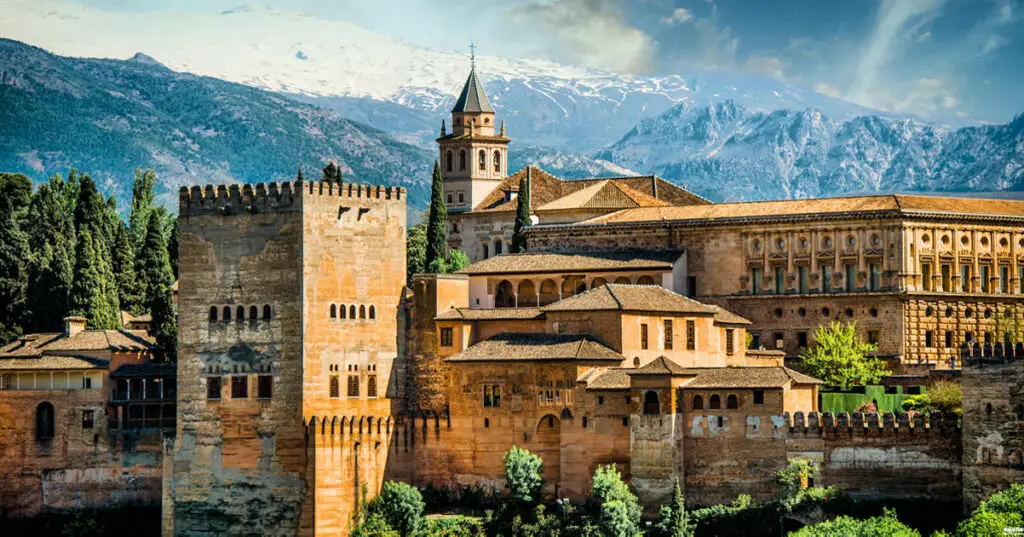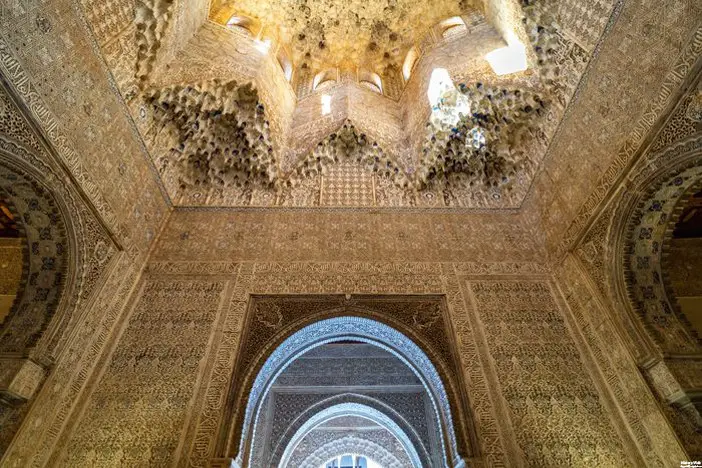The Alhambra: Gardens, Art, and Architectural Wonder

Introduction
Perched on a strategic hilltop in Granada, Spain, the Alhambra stands as one of the most breathtaking examples of Islamic art and architecture in the world. This palatial complex, with its stunning blend of gardens, fountains, and intricate design, symbolizes the zenith of Moorish culture in Spain. Originally constructed as a small fortress in 889 AD, it was transformed into a majestic palace in the mid-13th century by the Nasrid emirs, who made it their royal residence.
The Alhambra’s significance extends far beyond its physical beauty. It embodies the rich history of Al-Andalus, the Muslim-ruled region of Spain, and serves as a testament to the cultural and artistic achievements of the Nasrid dynasty. Over the centuries, it has inspired countless artists, writers, and travelers, each captivated by its harmonious architecture and serene gardens.
In this article, we will delve into the historical context of the Alhambra, explore the splendor of the Nasrid Palaces, wander through the enchanting Generalife Gardens, and examine the fortifications and towers that defended this architectural marvel. We will also appreciate the intricate Moorish art and decoration that adorn the complex and discuss the efforts to restore and conserve this UNESCO World Heritage site. Finally, we will provide practical tips for experiencing the Alhambra today, ensuring that every visitor can fully appreciate its timeless beauty and cultural significance.
The Historical Context

The story of the Alhambra begins in the 9th century, when a small fortress was constructed on the remains of Roman fortifications. It wasn’t until the 13th century, under the rule of the Nasrid dynasty, that the Alhambra was transformed into the splendid palace complex we see today. Mohammed I, the first Nasrid emir, initiated the construction of the Alhambra’s current form, choosing the location for its strategic advantages and stunning views of the surrounding area.
The Nasrid emirs continued to expand and embellish the Alhambra over the next century. Each ruler contributed to the complex, adding palaces, baths, towers, and extensive gardens. The result was a sophisticated ensemble that combined residential quarters, administrative offices, and a defensive citadel. The Alhambra became the political and cultural heart of the Nasrid Kingdom, reflecting its rulers’ wealth, power, and refined taste.
The fall of Granada to the Catholic Monarchs, Ferdinand and Isabella, in 1492 marked the end of Muslim rule in Spain and the beginning of significant changes to the Alhambra. The Christian conquerors made modifications to the complex, including the construction of the Renaissance-style Palace of Charles V. Despite these changes, much of the original Moorish architecture and decoration was preserved, allowing the Alhambra to retain its unique blend of cultural influences.
The Nasrid Palaces

The heart of the Alhambra lies in the Nasrid Palaces, a series of interconnected buildings that served as the royal residence of the Nasrid emirs. Among the most famous of these is the Comares Palace, known for its stunning Hall of the Ambassadors. This grand hall served as the emir’s throne room and is adorned with intricate stucco work, colorful tile mosaics, and elaborate wooden ceilings. The hall’s walls are covered with Arabic inscriptions, including verses from the Quran and poetry praising the beauty of the palace.
Adjacent to the Comares Palace is the Palace of the Lions, named after its iconic central courtyard, the Court of the Lions. This courtyard is surrounded by an arcade of delicate columns and features a central fountain supported by twelve marble lions. The fountain and the surrounding gardens symbolize the paradise described in Islamic texts, representing an ideal of beauty and tranquility. The Hall of the Abencerrajes, located off the Court of the Lions, is another highlight, with its star-shaped dome and elaborate muqarnas (stalactite-like) decorations.
Each room and courtyard within the Nasrid Palaces is designed to create a sense of harmony and balance, reflecting the Islamic principles of geometry and proportion. The use of light and water further enhances this effect, with sunlight streaming through intricately carved windows and water flowing through channels and fountains, creating a serene and meditative atmosphere. The Nasrid Palaces are a testament to the architectural and artistic achievements of the Nasrid dynasty, showcasing their ability to blend function and beauty seamlessly.
The Generalife Gardens

Located adjacent to the Alhambra is the Generalife, the summer palace and gardens of the Nasrid emirs. The Generalife, meaning “Garden of the Architect” in Arabic, served as a place of leisure and retreat, away from the formalities of court life. The gardens are renowned for their lush greenery, flowing water features, and breathtaking views of the Alhambra and the city of Granada.
The design of the Generalife Gardens follows the traditional Islamic garden layout, with a focus on symmetry, order, and the integration of natural elements. The Patio de la Acequia, or Court of the Water Channel, is the centerpiece of the gardens, featuring a long reflecting pool bordered by flowerbeds, fountains, and colonnades. The soothing sound of running water, combined with the fragrance of the gardens’ plants and flowers, creates a peaceful and refreshing environment.
The Generalife also includes several pavilions and terraces, where the Nasrid rulers could relax and enjoy the beauty of their surroundings. The Upper Gardens offer panoramic views of the Alhambra, the Albaicín quarter, and the Sierra Nevada mountains, providing a stunning backdrop to the serene landscape. The integration of nature and architecture in the Generalife reflects the Nasrid’s deep appreciation for the natural world and their desire to create a harmonious living environment.
Fortifications and Towers

The Alhambra’s fortifications and towers are a testament to its strategic importance as a military stronghold. The Alcazaba, the oldest part of the Alhambra, served as the military fortress and housed the garrison that defended the complex. Its massive walls and towers provide commanding views of the surrounding area, allowing the Nasrid rulers to monitor and protect their territory effectively.
Among the most notable towers in the Alcazaba are the Torre de la Vela and the Torre del Homenaje. The Torre de la Vela, or Watchtower, is the tallest tower in the Alhambra and offers panoramic views of Granada and the surrounding countryside. The tower’s bell, which was added during the Christian period, played a crucial role in the city’s defense, signaling the approach of enemy forces and marking important events. The Torre del Homenaje, or Keep Tower, served as the main defensive stronghold within the Alcazaba, with its thick walls and commanding presence.
In addition to the Alcazaba, the Alhambra features several other towers and defensive structures that contribute to its overall fortification. The Nasrid rulers recognized the importance of maintaining a strong defense, and their efforts are evident in the complex’s robust and well-preserved fortifications. These structures not only served a practical purpose but also symbolized the power and resilience of the Nasrid dynasty.
Moorish Art and Decoration

The Alhambra is renowned for its exquisite Moorish art and decoration, which reflect the cultural and artistic achievements of the Nasrid dynasty. The intricate stucco work, tile mosaics, and calligraphy that adorn the walls and ceilings of the Alhambra are a testament to the skill and creativity of the artisans who created them. These decorative elements are characterized by their geometric patterns, arabesques, and floral motifs, which are commonly found in Islamic art.
One of the most striking features of the Alhambra’s decoration is the use of muqarnas, a form of ornamental vaulting that creates a honeycomb-like effect. This technique is used extensively in the Hall of the Abencerrajes and the Hall of the Two Sisters, creating a sense of depth and complexity that enhances the overall beauty of the space. The muqarnas are often combined with intricate stucco work and colorful tile mosaics, creating a rich and visually stunning environment.
Calligraphy also plays a significant role in the decoration of the Alhambra, with verses from the Quran and poetic inscriptions adorning the walls and ceilings. These inscriptions not only serve a decorative purpose but also convey spiritual and philosophical messages, reflecting the deep religious and cultural beliefs of the Nasrid rulers. The combination of calligraphy, geometric patterns, and floral motifs creates a harmonious and unified aesthetic that is both visually captivating and culturally significant.
Restoration and Conservation
The Alhambra has faced numerous challenges over the centuries, including neglect, vandalism, and the effects of natural aging. However, extensive restoration and conservation efforts have been undertaken to preserve this architectural masterpiece and ensure its continued survival. These efforts began in earnest in the 19th century, with scholars and architects recognizing the importance of the Alhambra’s historical and cultural significance.
One of the most significant milestones in the Alhambra’s preservation was its designation as a UNESCO World Heritage site in 1984. This recognition brought international attention to the importance of preserving the Alhambra and provided funding and resources for ongoing restoration efforts. The goal of these efforts has been to maintain the Alhambra’s historical integrity while making it accessible to the public.
Modern conservation work at the Alhambra includes the stabilization of structures, the restoration of decorative elements, and the implementation of measures to protect the site from environmental damage. These efforts are guided by a commitment to preserving the authenticity and historical value of the Alhambra, ensuring that future generations can continue to appreciate its beauty and significance.
Experiencing the Alhambra Today
Visiting the Alhambra is a unique and unforgettable experience that allows visitors to immerse themselves in the rich history and stunning beauty of this architectural wonder. The Alhambra is open to the public year-round, with tickets available for both daytime and nighttime visits. It is advisable to book tickets in advance, as the site is one of Spain’s most popular tourist destinations and often reaches capacity.
Guided tours are available in multiple languages, providing valuable insights into the history, architecture, and cultural significance of the Alhambra. These tours offer a comprehensive overview of the site, covering the Nasrid Palaces, the Generalife Gardens, the Alcazaba, and other key areas. Self-guided tours are also an option, with audio guides available for those who prefer to explore at their own pace.
To make the most of a visit to the Alhambra, it is recommended to allocate several hours to fully explore the complex. Highlights include the Hall of the Ambassadors, the Court of the Lions, the Generalife Gardens, and the stunning views from the Alcazaba’s towers. The surrounding area of Granada also offers additional attractions, including the historic Albaicín quarter and the beautiful Sacromonte district, making a visit to the Alhambra part of a broader cultural and historical experience.
Conclusion

The Alhambra stands as a remarkable testament to the artistic, architectural, and cultural achievements of the Nasrid dynasty and the broader Islamic heritage of Spain. Its stunning gardens, intricate decoration, and strategic fortifications make it a unique and captivating destination that continues to inspire awe and admiration. The Alhambra’s significance extends beyond its physical beauty, embodying the rich history and cultural legacy of Al-Andalus.
As we have explored in this article, the Alhambra’s historical context, architectural highlights, and artistic contributions all contribute to its enduring legacy. The Generalife Gardens, the Nasrid Palaces, and the Alcazaba each offer a unique perspective on the Alhambra’s multifaceted significance. The ongoing restoration and conservation efforts ensure that this UNESCO World Heritage site remains a vibrant and accessible part of Spain’s cultural heritage.
For those fortunate enough to visit, the Alhambra provides a profound and immersive experience that allows them to connect with the rich history and cultural traditions of medieval Spain. It is a place where history and art converge, creating a timeless monument that continues to captivate the hearts and minds of all who encounter it. The Alhambra remains a beacon of cultural heritage, a symbol of the artistic and architectural genius of the Nasrid dynasty, and a testament to the enduring power of beauty and history.


